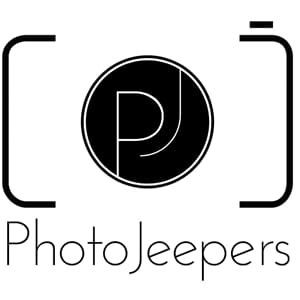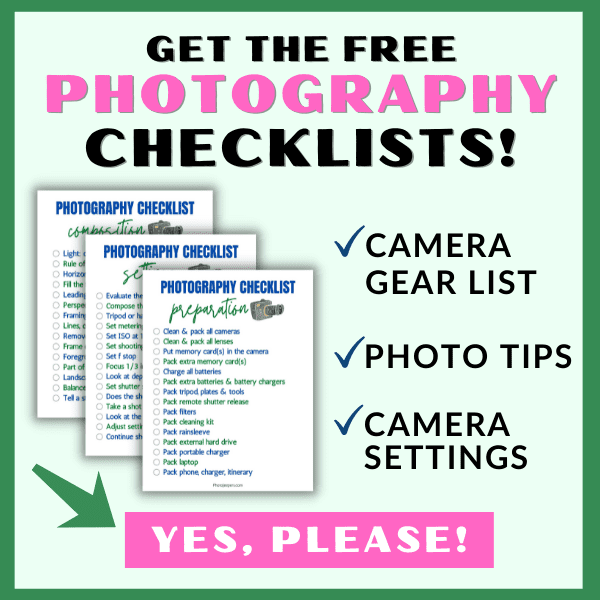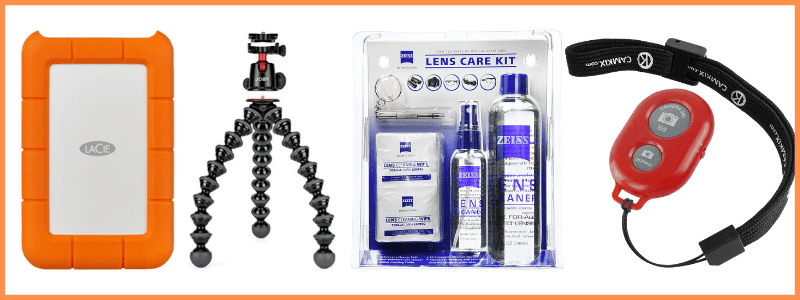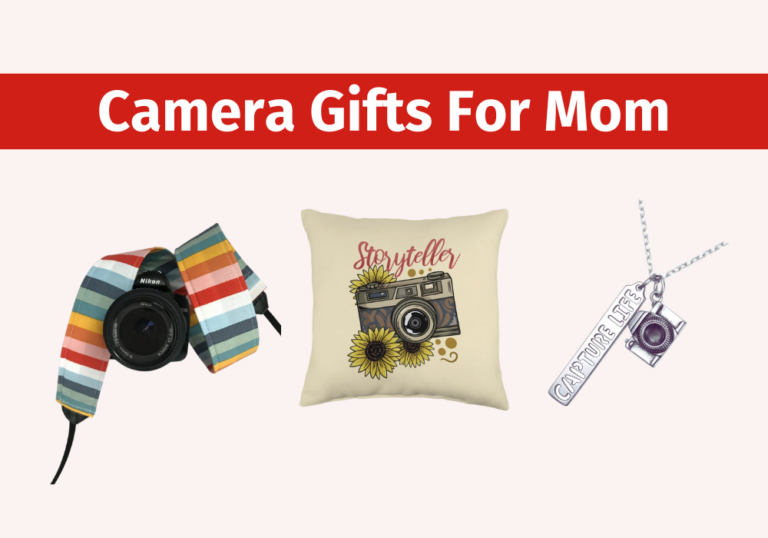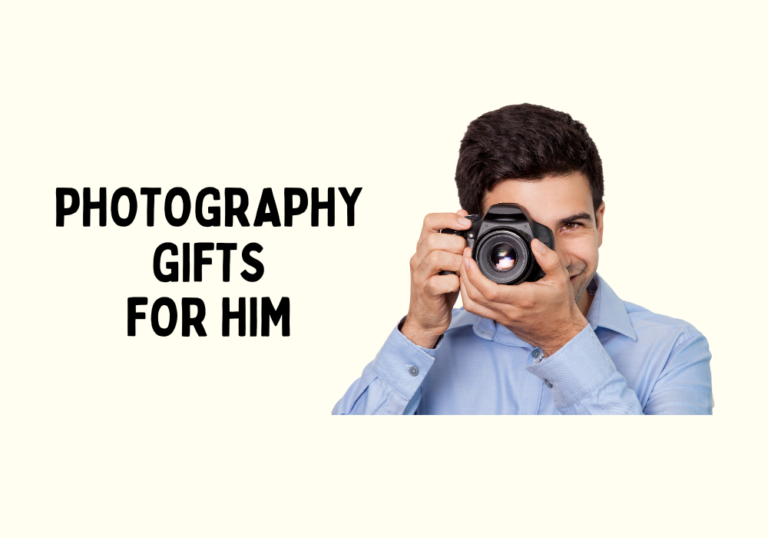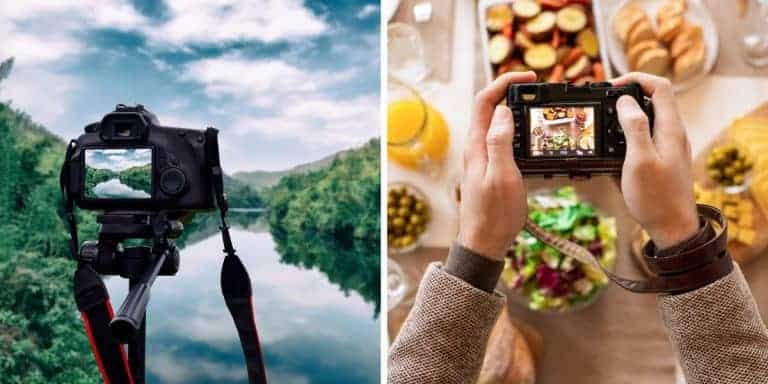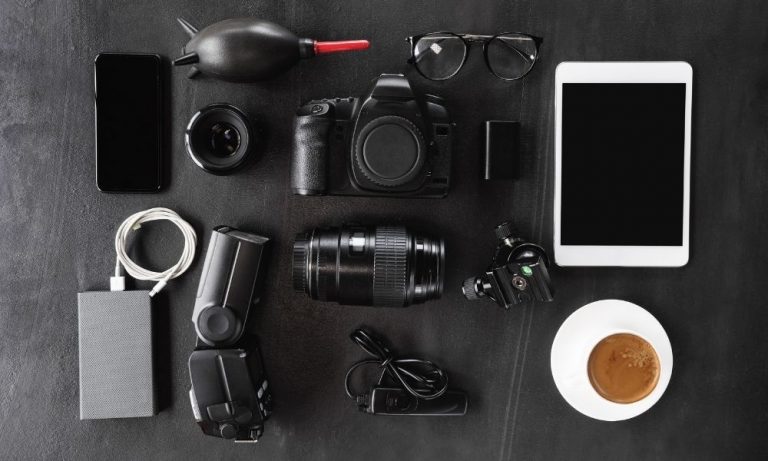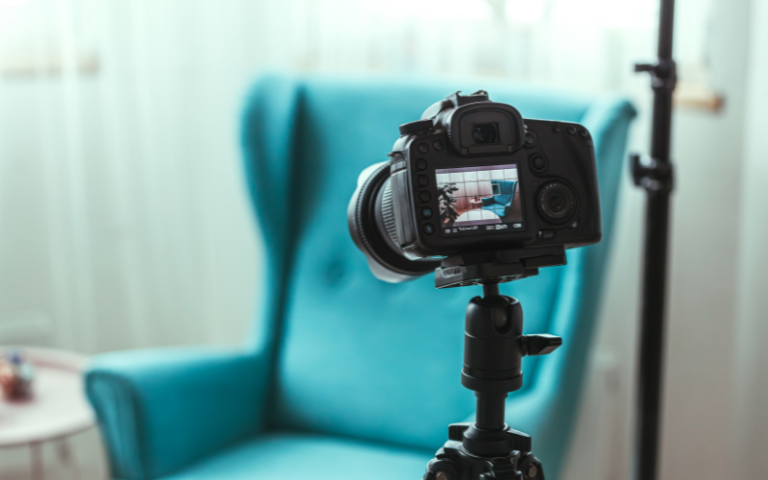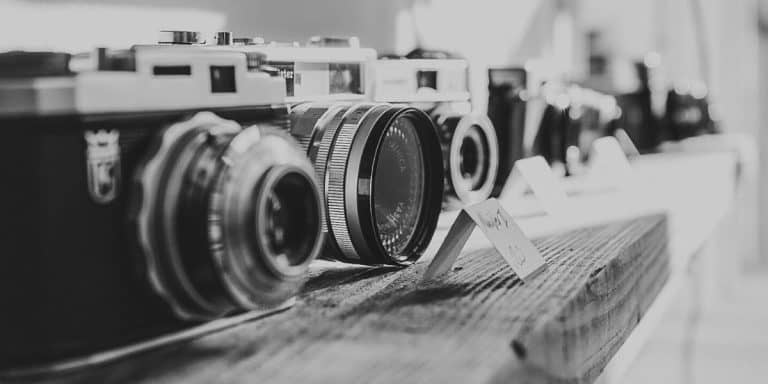Top 10 Best Vlogging Cameras for Beginners
Are you looking for the best vlogging cameras for beginners to add to your travel photography gear list? Finding a vlogging camera can be a tad overwhelming with all the options out there. The key here is to keep it simple.
Start by considering what exactly you’ll be using the camera for. Are you going to be a travel vlogger, a talk-head, or are you planning to document your everyday life? This will help you to figure out what features are most important to you.
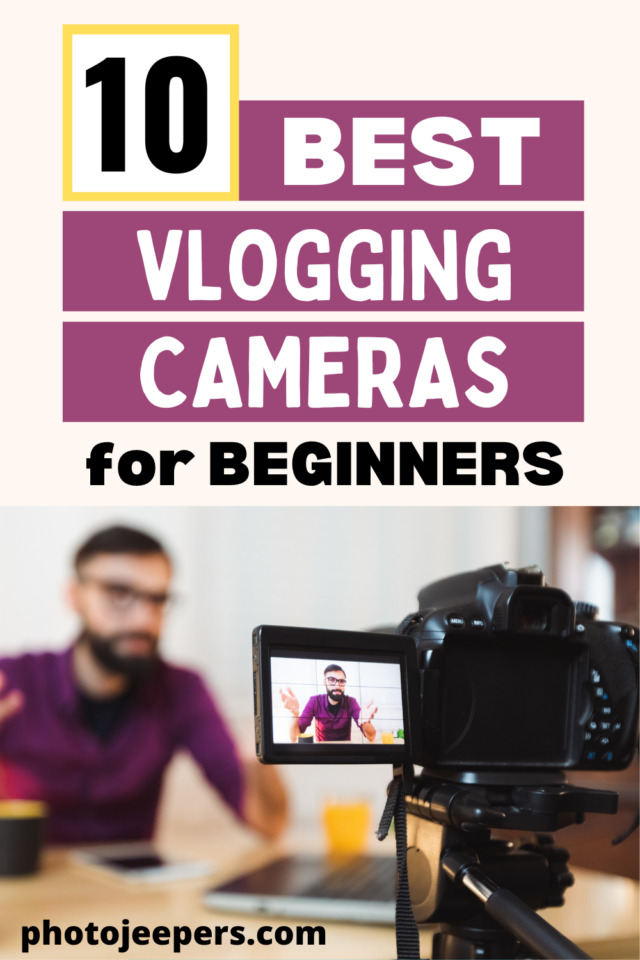
Our best tip for beginner vloggers: you don’t need an expensive camera to capture videos and take photos. Remember, you’re just starting out, so there’s no need to go all out on the most expensive camera.
There are plenty of budget-friendly options that offer great video quality. With a decent budget vlogging camera, you can shoot impressive videos for YouTube.
The vlogging cameras on our list feature easy-to-use controls and auto modes since they are designed to work in the hands of beginners.
If you plan to take photos in addition to videos, be sure to grab your free copy of our Photography Checklists by clicking the image below. You’ll get a packing list, settings list, and composition tips list that includes the top basic photography techniques to capture amazing photos!
This site contains affiliate links which means WE may receive commissions for purchases made through these links. We only provide links to products we actually use and/or wholeheartedly recommend! As an Amazon Associate, we earn from qualifying purchases. Read the full Disclosure Policy.
Best Vlogging Cameras for Beginners at a Glance
Here’s a chart to highlight the top 10 beginner-friendly vlogging cameras and their key features. Later in the article we’ll go into more detail for each camera and the vlogging features on this list.
| Camera | Type | Max Video | Slow Motion | Display | Recording Limit |
| Sony ZV-1 II | Compact | UHD 4K/30fps | Yes, 1080p/120fps | 3-inch Flip-Out Touchscreen | None |
| Sony ZV-E10 | Mirrorless | UHD 4K/30fps | Yes, 1080p/120fps | 3-inch Flip-Out Touchscreen | None |
| Canon G7X Mark III | Compact | UHD 4K/30fps | Yes, 1080p/120fps | 3-inch Flip-Up Touchscreen | Up to 30 Minutes |
| Sony ZV-1 | Compact | UHD 4K/30fps | Yes, 1080p/120fps | 3-inch Flip-Out Touchscreen | None |
| Canon M50 Mark II | Mirrorless | UHD 4K, 24fps | Yes, 720p/120fps | 3-inch Flip-Out Touchscreen | Up to 30 Minutes |
| OM System Tough TG-7 | Compact | UHD 4K/30fps | Yes, 1080p/120fps | 3-inch Fixed LCD | Up to 30 Minutes |
| GoPro HERO12 Black | Action | 5.3K/60fps | Yes, 4K/120fps | 2.27-inch Fixed Touchscreen | None |
| AKASO EK7000 Pro | Action | UHD 4K/25fps | — | 2-inch Fixed Touchscr | None |
| Canon EOS Rebel T8i | DSLR | UHD 4K/25fps | — | 3-inch Flip-Out Touchscreen | Up to 30 Minutes |
| Canon PowerShot V10 | Compact | UHD 4K/30fps | — | 2-inch Flip-Up Touchscreen | None |
Top 10 Best Vlogging Cameras for Beginners
Remember the first step to buying a vlogging camera is understanding the essential features available, and which ones you really need. Later in this article we explain all the features of vlogging cameras you should consider when buying your ideal camera for vlogging.
Here’s our list of the best beginner-friendly vlogging cameras with a list of features, pros, cons, and our thoughts about each one.
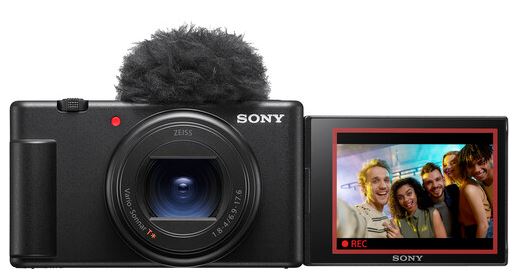
1. Sony ZV-1 II – Overall Best Vlogging Camera for Beginners
Key Features of the Sony ZV-1 II
- Type: Compact
- Sensor: 20.1MP 1″ Exmor RS BSI CMOS Sensor
- Display: 3.0″ Articulating Touchscreen LCD
- Image Stabilization: Digital (Video Only)
- Zoom: 18-50mm-Equivalent f/1.8-4 Wide-Angle Zoom Lens
- Max. Video: UHD 4K/30fps & 1080p/120fps for Slow Motion
- Record Limit: None
- Connectivity: USB-C, 3.5mm Mic, Micro-HDMI, & Wi-Fi
- Battery Life: 290 Shots
- Weight: 292g (Body with Battery & SD Card)
Sony released the ZV-1 in May 2020 as a vlogging-focused camera. It immediately became a favorite for most beginner and enthusiast lifestyle vloggers.
The Sony ZV-1 II is ultra-compact with a lightweight design and built-in features including an OIS, a long-range zoom, and slow motion capabilities.
It’s an updated version of the ZV-1 and brings three key improvements that most vloggers had requested after using the ZV-1 for over two years.
These features include a wider FOV, an upgraded 3-capsule microphone, and excellent touchscreen controls for seamless operation on the go.
Pros:
- A sleek, ultra-portable design for on-the-go vlogging.
- A built-in mic with impressive audio quality.
- The USB-C port supports power delivery and data transfer.
- It has an improved battery life compared to the ZV-1.
- It’s compatible with Sony Creator’s iOS/Android app.
- A wider field of view for front-facing group vlogs, podcasts, etc.
- Enhanced autofocus features, including multiple face recognition.
- It supports live streaming by connecting to a PC/laptop via USB-C.
Cons:
- It only has digital image stabilization instead of optical.
- It lacks an on-body flashlight but has a hotshoe.
The Sony ZV-1 II is an excellent, beginner-friendly vlogging camera with outstanding image quality, 4K/30fps video capabilities, and a super-handy USB-C!
It lacks the OIS present in the ZV-1. And while vloggers will benefit from the EIS, we recommend getting it with the Sony GP-VPT2BT Wireless Shooting Grip.
Check Prices: Sony ZV-1 II
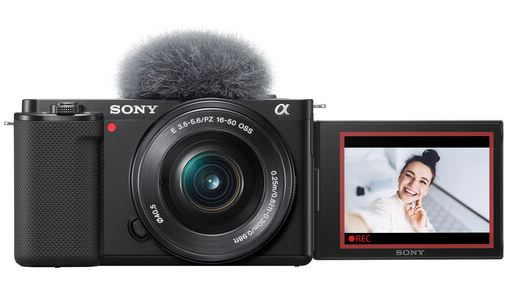
2. Sony ZV-E10 – Best Mirrorless Vlogging Camera for Beginners
Key Features of the Sony ZV-E10
- Type: Mirrorless
- Sensor: 24.2MP APS-C Exmor CMOS Sensor
- Display: 3.0″ Side Flip-Out Touchscreen LCD
- Image Stabilization: Digital (Video Only)
- Zoom: Depends on the Lens in Use
- Max. Video: UHD 4K/30fps & 1080p/120fps for Slow Motion
- Record Limit: None
- Connectivity: USB-C, Micro-HDMI, Wi-Fi, Bluetooth, 3.5mm Mic, & 3.5mm Headphone
- Battery Life: 440 Shots
- Weight: 343g (Body with Battery & SD Card)
The Sony ZV-E10 is the perfect vlogging camera for beginners who want superior image quality, the freedom of using multiple lenses, and a better battery life!
The ability to switch up the lenses expands its versatility to most types of vlogging, from travel to food and products, etc., for YouTube, TikTok, and other platforms.
ZV-E10 also has a three-capsule mic for great audio from the camera and excellent autofocus features, including Real-Time Eye AF and Tracking.
While it only has an EIS that works for video, enthusiast vloggers will benefit from versatile lenses like the Sony E 18-135mm F3.5-5.6 OSS, which have OIS.
Pros:
- It’s hands down the best vlogging camera for travel vlogs.
- A compact, ultra-portable design with a nice grip.
- It’s excellent for both indoor and on-the-go vlogging.
- It supports live streaming right from the camera.
- The USB-C supports data transfer and power input.
- An impressive battery life for up to 440 shots.
- A hotshoe to hook up an external mic or flash.
- A perfect camera for vloggers who also want great stills.
Cons:
- It lacks on-body flash but has a hotshoe.
- It lacks a viewfinder that would benefit still shooters.
- Does a subpar job when capturing fast action like car reviews.
The Sony ZV-E10 is slightly bigger and heavier than the ZV-1 II. But it is still comfortable to use on the go and easily fits in a purse or a tiny backpack.
We recommend getting the Sony GP-VPT2BT Wireless Shooting Grip or a gimbal for an effortless on-the-go shooting experience and smooth video quality.
Check Prices: Sony ZV-E10
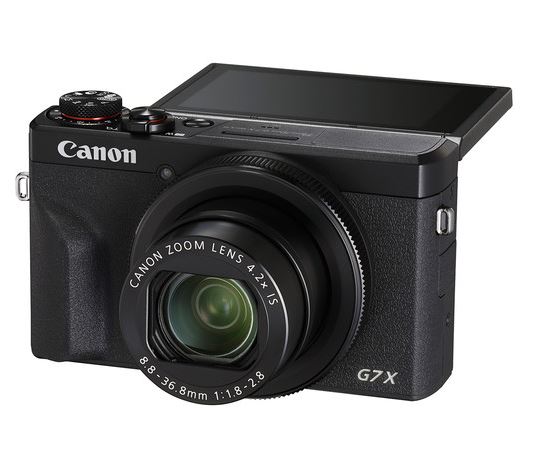
3. Canon G7X Mark III – Best Affordable Vlogging Camera for Beginners
Key Features of the Canon G7X Mark III
- Type: Compact
- Sensor: 20.2MP 1″ Stacked CMOS Sensor
- Display: 3.0″ 1.04m-Dot Tilting Touchscreen LCD
- Image Stabilization: Optical in Integrated Lens
- Zoom: 24-100mm-Equivalent f/1.8-2.8 Optical Zoom Lens
- Max. Video: UHD 4K/30fps & 1080p/120fps for Slow Motion
- Record Limit: Up to 10 Minutes in 4K & 30 Minutes in 1080p
- Connectivity: USB Type-C, Micro-HDMI, 3.5mm Mic, Bluetooth, & Wi-Fi
- Battery Life: 320 Shots
- Weight: 304g (Body with Battery & SD Card)
Before Sony took over the world of compact content creation and vlogging cameras, Canon reigned supreme with the G7X Mark II and Mark III.
The G7X Mark II was an instant favorite for most lifestyle and travel vloggers when it came out in February 2016, and the Mark III followed suit!
Canon G7X Mark III has 4K/30fps and 1080p/120fps video capabilities for slow motion. It boasts a faster shutter and impressive low-light performance.
Like the Sony ZV-1 II, the G7X Mark III has a sleek, compact, ultralightweight design for portability. It’ll easily fit in a small purse or pocket for on-the-go vlogging.
A unique feature of the G7X Mark III is its built-in feature that lets you connect your YouTube channel to the camera and live stream directly and wirelessly via WiFi.
You can connect an external mic to ramp up the audio for superior sound quality when live streaming and vlogging in places with a lot of background noise.
Pros:
- It’s sleek, ultra-lightweight, and super-compact.
- Its battery life is much better than Sony’s ZV-1.
- It has a pop-up flash that makes it great for shooting stills.
- Built-in ND filters to benefit vlogging in the daylight.
- It shoots Full HD 1080p up to 120fps for slow motion.
- It supports wireless YouTube live streaming via WiFi.
- The USB-C supports power input and super-fast file transfer.
- It has verticle video support, which is great for TikTok.
- It has a 20fps and 30fps burst rate for JPEGs and RAW.
- You can use it while charging from an outlet or power bank.
- The flip-up screen is excellent for street vlogging.
Cons:
- It has a record limit of 10 minutes for 4K videos.
- Its autofocus can’t match that of the Sony ZV-1 II.
- The built-in mic is awful in places with a lot of background noise.
- It lacks a hotshoe for mounting an external mic.
Over four years since its first release, the Canon G7X Mark III is still a top seller! It’s among the best vlogging cameras for beginners on YouTube and TikTok.
The superior 4K/30fps video capabilities, a powerful DIGIC 8 image processor, the sleek design, and useful vlogging features make it a perfect choice for beginners.
We recommend getting it with the HG-100TBR Tripod Grip and the ingeniously designed UURig G7X Mark III Vlog Camera Cold Shoe for an external mic!
Check Prices: Canon G7X Mark III
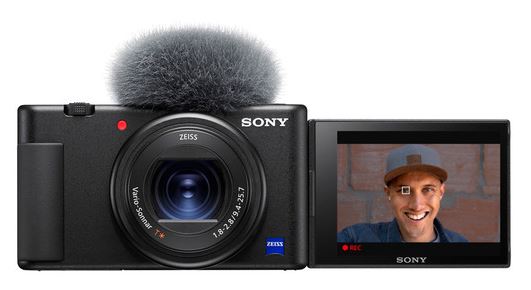
4. Sony ZV-1 – Alternative Affordable Vlogging Camera for Beginners
Key Features of the Sony ZV-1
- Type: Compact
- Sensor: 20.1MP 1″ Exmor RS BSI CMOS Sensor
- Display: 3.0″ Articulating Touchscreen LCD
- Image Stabilization: Optical SteadyShot Image Stabilization
- Zoom: 24-70mm-Equivalent f/1.8-2.8 Wide-Angle Zoom Lens
- Max. Video: UHD 4K/30fps & 1080p/120fps for Slow Motion
- Record Limit: None
- Connectivity: Micro-USB 2.0, 3.5mm Mic, Micro-HDMI, Bluetooth, & Wi-Fi
- Battery Life: 260 Shots
- Weight: 294g (Body with Battery & SD Card)
Sony often keeps its cameras in circulation long after releasing their updated variations. Thus, the Sony ZV-1 is still an excellent choice for most beginner vloggers.
ZV-1 won the hearts of many YouTube and TikTok content creators due to its impressive image quality when doing unboxing reviews and product showcasing vlogs.
It’s also a widely used camera by travel and lifestyle vloggers who shoot daily videos, BTS footage, tutorial-based content, and other trending online challenges!
Whereas its built-in stereo mic has good audio quality, it isn’t as great as you would get with the ZV-1 II three-capsule multidirectional microphone.
We recommend the ZV-1 for shooting one-person vlogs indoors and on the go when traveling. The ZV-1 II does better for group vlogs, like conversational podcasts, due to its wider FOV and superior mic.
It’s worth noting that both have other useful features like Background DeFocus for blurring the background, Face Priority Auto-Exposure, and better low-light performance.
Pros:
- A super compact, ultralightweight build design.
- Active SteadyShot image stabilization for smooth footage.
- It supports live streaming by connecting to a PC/laptop via USB.
- The Micro-USB port supports power input and data transfer.
- A flip-out touchscreen for selfie-mode vlogging.
- A Soft Skin Effect to soften and smooth wrinkles when recording.
- It has plenty of other content creation and vlogging features.
Cons:
- A subpar battery life, but you can vlog while charging.
- It lacks a flashlight but has a hot shoe mount.
- The USB port isn’t Type-C, unlike the updated ZV-1 II.
Over three years after its release, the Sony ZV-1 is still worth buying for most one-person video content creation and vlogging. Indoors and on the go!
It has no recording limit, and the battery lasts about 1 hour when shooting at 1080p. But good enough, the Micro-USB port lets you shoot while charging.
To enjoy a seamless vlogging experience, we recommend getting it as a kit with the Sony GP-VPT2BT Wireless Shooting Grip that serves as a grip and tripod.
Check Prices: Sony ZV-1
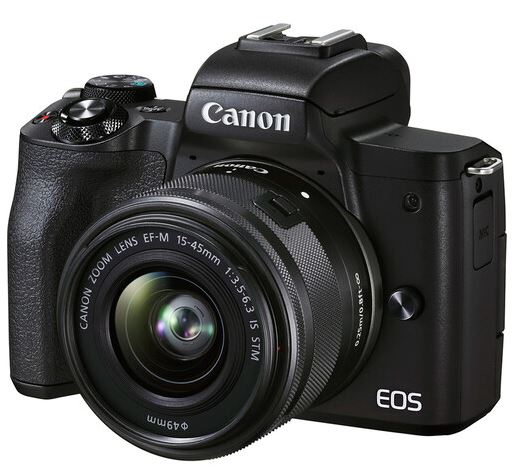
5. Canon M50 Mark II – Best Affordable Mirrorless Camera for Vlogging
Key Features of the Canon M50 Mark II
- Type: Mirrorless
- Sensor: 24.1MP APS-C CMOS Sensor
- Display: 3.0″ 1.04m-Dot Articulating Touchscreen
- Image Stabilization: Digital, 5-Axis (Video Only)
- Zoom: Depends on the Lens in Use
- Max. Video: UHD 4K/24fps & 720p/120fps for Slow Motion
- Record Limit: Up to 30 Minutes
- Connectivity: Micro-USB 2.0, Micro-HDMI, 3.5mm Mic, Bluetooth, & Wi-Fi with NFC
- Battery Life: 305 Shots
- Weight: 387g (Body with Battery & SD Card)
The Canon M50 Mark II was the best mirrorless camera for vlogging since its release in October 2020 until July 2021, when Sony introduced the ZV-E10.
M50 Mark II comes with a 15-45mm kit lens at about $100 cheaper than the ZV-E10 without any lens, making it an affordable option for beginner vloggers on a budget.
The M50 Mark II has a 24.1MP APS-C CMOS Sensor and a DIGIC 8 image processor that shoots clear 4K/24fps, 1080p/60fps, and 720p/120fps video footage.
Canon specifically designed it for content creators and vloggers. It has a compact and ultra-lightweight design for portability with a nice right-hand grip.
The M50 Mark II uses the older Canon EF-M lens mount! It’s a great feature because you can get versatile, powerful, compatible lenses at huge bargains.
Pros:
- A compact and lightweight design for portability.
- It has a simple beginner mode to suit entry-level vloggers.
- It has a built-in flash to benefit shooting stills.
- It offers both live streaming and webcam functionalities.
- It has a 2.36m-Dot OLED Electronic Viewfinder.
- The screen has a touch autofocus with subject tracking.
- It has a hot shoe and a 3.5mm port for an external mic.
Cons:
- A Type-C USB would be better.
- It has a subpar battery life.
The Canon M50 Mark II stands out for its vibrant image quality even in low light conditions. It has excellent autofocus features for both videos and photos.
For most beginner vloggers, the Canon EF-M 15-45mm IS STM kit lens is a good place to start. It has a 35mm equivalent focal length range of 24 to 74mm.
While its on-body image stabilization is digital and works for video only, there are plenty of affordable Canon EF-M compatible lenses with built-in Optical IS.
Check Prices: Canon M50 Mark II
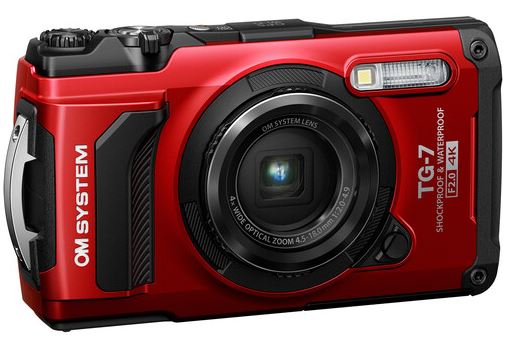
6. OM System Tough TG-7 – Best Vlogging Camera for Extreme Adventures
Key Features of the OM System Tough TG-7
- Type: Compact
- Sensor: 12M 1/2.3-Type BSI CMOS Sensor
- Display: 3.0” 1.037m-Dot Fixed LCD
- Image Stabilization: Sensor-Shift
- Zoom: 25-100mm-Equivalent f/2-4.9 4x Optical Zoom Lens
- Max. Video: UHD 4K/30fps
- Record Limit: Up to 30 Minutes
- Connectivity: Micro-USB Type-C, Micro-HDMI, Bluetooth, & Wi-Fi
- Battery Life: 340 Shots
- Weight: 249g (Body with Battery & SD Card)
OM System, formerly Olympus, designs the TG rugged cameras for extreme adventures. They are waterproof, shockproof, crushproof, dustproof, and freezeproof!
The OM System Tough TG-7 is the latest addition to the TG lineup. Apart from the rebranded name update, it has an upgraded ribbed plastic front grip and lens ring!
The Tough TG-6 was the go-to vlogging and photography camera for shooting extreme adventures like rock climbing, water skiing, and construction zones.
The TG-7 still features the same 12MP BSI CMOS Sensor and TruePic VIII image processor for excellent image quality even in low-light conditions.
It shoots clear 4K/30fps videos and 1080p/120fps footage for slow-motion. The image quality is good but not as great as what you would get with the ZV-1 II.
Pros:
- A compact, lightweight, rugged build quality.
- It’s built to withstand the harshest of conditions.
- A great battery life to last through your adventure.
- It has a built-in flash to benefit shooting stills.
- You can shoot time-lapse and vertical videos for TikTok.
- It shoots 720p at 480fps for extreme slow motion.
- The USB-C supports power input and ultrafast data transfer.
- It has a built-in GPS, compass, thermometer, and barometer.
- It’s compatible with the OM Image Share app.
- It offers plenty of beginner-friendly shooting modes.
- You can take it and shoot 15 meters underwater.
Cons:
- It lacks a 3.5mm port for an external mic.
- The display is fixed and not a touchscreen.
Aside from its rugged and durable build quality and the built-in video and photo features, the Tough TG-7 is exceptionally easy-to-use to suit beginner vloggers.
It supports an array of compatible accessories, including the RM-WR1 wireless remote controller, CHS-09 Float Strap, and telephoto and fisheye converter lenses.
Check Prices: OM System Tough TG-7
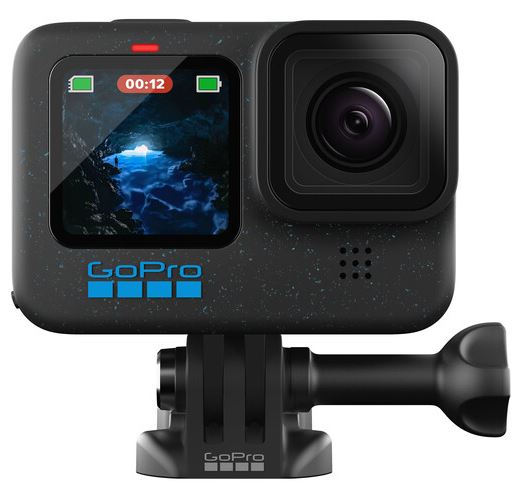
7. GoPro HERO12 Black – Best Vlogging Camera for Fast-Paced Action
Key Features of the GoPro HERO12
- Type: Action
- Sensor: 27MP CMOS Image Sensor
- Display: Rear 2.27″ Fixed Touchscreen LCD & Front 1.4″ LCD Live-View Monitor
- Image Stabilization: HyperSmooth 6.0
- Zoom: 12 to 39mm-Equivalent f/2.5 Zoom Lens
- Max. Video: 5.3K/60fps, UHD 4K/120fps
- Record Limit: None
- Connectivity: USB Type-C, Bluetooth, Wi-Fi
- Battery Life: Up to 1.5 Hours (1080p/30fps)
- Weight: 154g (Body with Battery & SD Card)
Action cameras are specifically designed for shooting fast-paced action, like car reviews, off-road biking, cycling, and most action sport athletics. The GoPro has always been the go-to action camera due to its exceptional build quality and excellent image capabilities among other features!
Go Pro HERO12 Black has a 27MP image sensor and HyperSmooth 6.0 image stabilization to capture smooth, crisp, clear videos up to 5.3K/60fps.
It records up to 4K/120fps footage for high-quality slow motion vlogs and up to 2.7K/240fps for super slow motion and other cinematic effects.
The built-in Bluetooth lets you connect the HERO12 with a wireless microphone for superior audio quality or wireless headphones to monitor the audio.
Pros:
- A robust build design that’s waterproof to 10 meters.
- The HERO12 is weatherproof and extremely durable.
- It shoots crisp 5.3K and 4K HDR videos and photos.
- It has the world-leading HyperSmooth 6.0 image stabilization!
- It’s compatible with the GoPro Quik iOS app.
- Built-in night effects, time lapse, and timecode sync.
- A 156° Angle of View for panoramic footage.
- It has simple point-and-shoot controls to suit beginners.
- A single battery records 5.3K/60fps for up to 70 minutes.
Cons:
- It’s quite pricey compared to other action cameras.
The GoPro HERO12 Black is exceptionally built with powerful imaging capabilities and a durable design, making it the best action camera in the world!
It shoots stunning videos and stills. The image stabilization is best-in-class for recording fast-paced action like biking, star trails, wild animals, and car reviews.
Vloggers will benefits from the 8x slow motion at 2.7K, crisp-clear 4K/120fps footage for YouTube, and high-quality 27MP photos for their social platforms.
Check Prices: GoPro HERO12
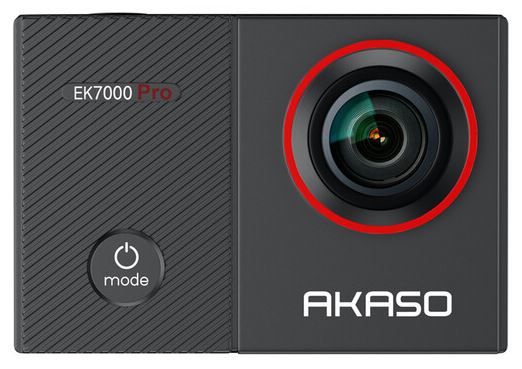
8. AKASO EK7000 Pro – Best Budget Vlogging Camera for Beginners
Key Features of the AKASO EK7000 Pro
- Type: Action
- Sensor: 16MP Size-Unspecified CMOS
- Display: 2” Fixed Touchscreen LCD
- Image Stabilization: Digital
- Zoom: Unspecified
- Max. Video: UHD 4K/25fps
- Record Limit: None
- Connectivity: Micro-USB, Micro-HDMI, & Wi-Fi
- Battery Life: Up to 1.5 Hours per Charge
- Weight: 61g (Body with Battery & SD Card)
The GoPro is hands down the world’s best action camera. But its high-end price and expensive accessories maybe out of reach for beginner vloggers.
The AKASO EK7000 Pro is a well-built, budget-friendly action camera with great imaging capabilities and costs a fraction of the GoPro HERO12 Black.
EK7000 Pro has a 16MP image sensor that records UHD 4K/25fps, 2.7K/30fps, 1080p/60fps, and 720p/60fps, and shoots high-quality 16MP stills.
Pros:
- It’s super-affordable, well-built, and ultra-portable.
- It has a 170° angle of view for panoramic footage.
- The built-in mic provides good-quality audio.
- It’s waterproof up to 40 meters with included housing.
- It has plenty of creative effects to enhance your vlogs.
- The battery life is quite great for a budget camera.
- It’s compatible with the iSmart DV app.
- It comes with 2-prong, handlebar, and helmet mounts.
Cons:
- It lacks 120fps video capabilities for slow motion.
The AKASO EK7000 Pro does almost everything the GoPro does, except slow-motion videos. Its image quality is good but not as crisp as the GoPro’s.
But you still get high-quality 4K/25fps and 1080p/60fps footage, time-lapse, burst mode shooting, and high-quality 16MP stills for your social media platforms.
The package includes waterproof housing, a remote control, two 1050mAh batteries, a dual-bay battery charger, and a USB cable, among other accessories.
Check Prices: AKASO EK7000 Pro

9. Canon EOS Rebel T8i – Best DSLR Vlogging Camera for Beginners
Key Features of the Canon EOS Rebel T8i
- Type: DSLR
- Sensor: 24.1MP APS-C CMOS Sensor
- Display: 3.0″ 1.04m-Dot Vari-Angle Touchscreen
- Image Stabilization: Digital, 5-Axis (Video Only)
- Zoom: Depends on the Lens in Use
- Max. Video: UHD 4K/24p
- Record Limit: Up to 30 Minutes
- Connectivity: Micro-USB, Micro-HDMI, Canon E3, 3.5mm Mic, Bluetooth, & Wi-Fi with NFC
- Battery Life: 1240 Shots
- Weight: 515g (Body with Battery & SD Card)
DSLR cameras provide the versatility of using multiple lenses, excellent battery life, and a hot shoe to mount accessories, including the best microphones. But their bulky and heavy build design makes them unideal for travel and on-the-go vloggers who want to pack everything in a small backpack or purse.
If you don’t mind its size and weight, we recommend getting the Canon EOS Rebel T8i with the 18-55mm IS STM kit lens so you can enjoy the DSLR convenience.
The Rebel T8i has a 24.1MP APS-C CMOS Sensor, DIGIC 8 Image Processor, and 45-Point All Cross-Type Phase-Detect AF for high-quality videos and stills.
Pros:
- It’s affordable, beginner-friendly, and sturdily built!
- It shoots up to UHD 4K/24fps and 1080p/60fps.
- It has a super-fast autofocus system with subject tracking.
- An optical viewfinder to benefit shooting stills.
- It’s compatible with the Canon Camera Connect app.
- An impressive battery life of up to 1240 shots.
- Canon EF-S compatible lenses are affordable!
Cons:
- The DSLR design is quite bulky and heavy!
- The Dual Pixel AF doesn’t work in 4K.
- It lacks the slow-motion capabilities of the G7X Mark III.
The Canon EOS Rebel T8i with the 18-55mm IS STM kit lens is a great starting point for vloggers who want a versatile DSLR camera with great imaging capabilities.
Rebel T8i has a powerful sensor, faster processor, and speedy autofocus to deliver high-quality UHD 4K videos and stills. It also records great-quality audio.
The hot shoe allows you to mount a large external microphone for superior audio quality, especially when shooting on the go in places with background noise!
Check Prices: Canon EOS Rebel T8i
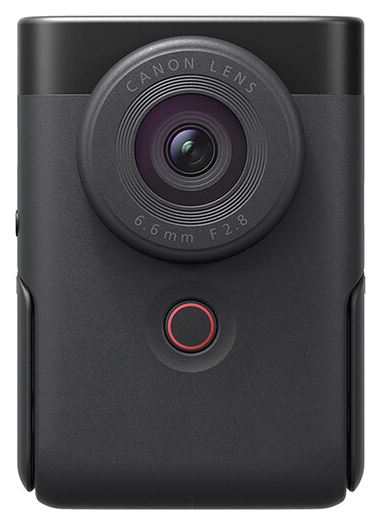
10. Canon PowerShot V10 – Beginners Budget Camera for Vlogging and Live Streaming
Key Features of the Canon PowerShot V10
- Type: Compact
- Sensor: 20.9MP 1″-Type CMOS Sensor
- Display: 2” 460k-Dot 180° Tilting Touchscreen LCD
- Image Stabilization: Digital
- Zoom: 3x Digital
- Max. Video: UHD 4K/30fps
- Record Limit: None
- Connectivity: Micro-USB-C, Micro-HDMI, 3.5mm Mic, Bluetooth, & Wi-Fi
- Battery Life: Up to 55 Minutes (4K/30fps)
- Weight: 211g (Body with Battery & SD Card)
The Canon PowerShot V10 is a powerful, pocketable compact camera for vlogging and live streaming on Tiktok, YouTube, and other platforms.
It has a 19mm wide-angle lens that records crispy clear 4K/30fps and 1080p/60fps vlogs. And the built-in stereo mic records high audio quality.
A unique feature of the PowerShot V10 is the built-in 30° stand. It lets you set the camera in front of you and record without needing a tripod.
Pros:
- It’s affordable, lightweight, ultra-compact, and pocketable!
- A beginner-friendly design to suit entry-level vloggers.
- It supports Full HD 1080p livestreaming at 30fps.
- The built-in microphone records high-quality audio.
- It has built-in ND filters to benefit shooting in the daylight.
- The USB-C supports power input and ultra-fast data transfer.
- It’s the perfect camera for TikTok and YouTube Shorts!
- You can use the camera while charging via the USB-C port.
- It’s compatible with the Canon Camera Connect app.
Cons:
- It lacks slow-motion capabilities.
- It lacks a hot shoe for accessories.
The Canon PowerShot V10 suits YouTubers and TikTok vloggers who shoot storytelling-style content about their daily lives, product showcasing, and travel.
It’s designed to rest on your palm, table, or any flat surface so you can sit in front of the screen and record or do a live stream without complicated accessories.
The PowerShot V10 is super-lightweight and ultra-compact to fit inside your pocket. It takes two hours to charge fully. The battery lasts about 55 minutes!
Check Prices: Canon PowerShot V10
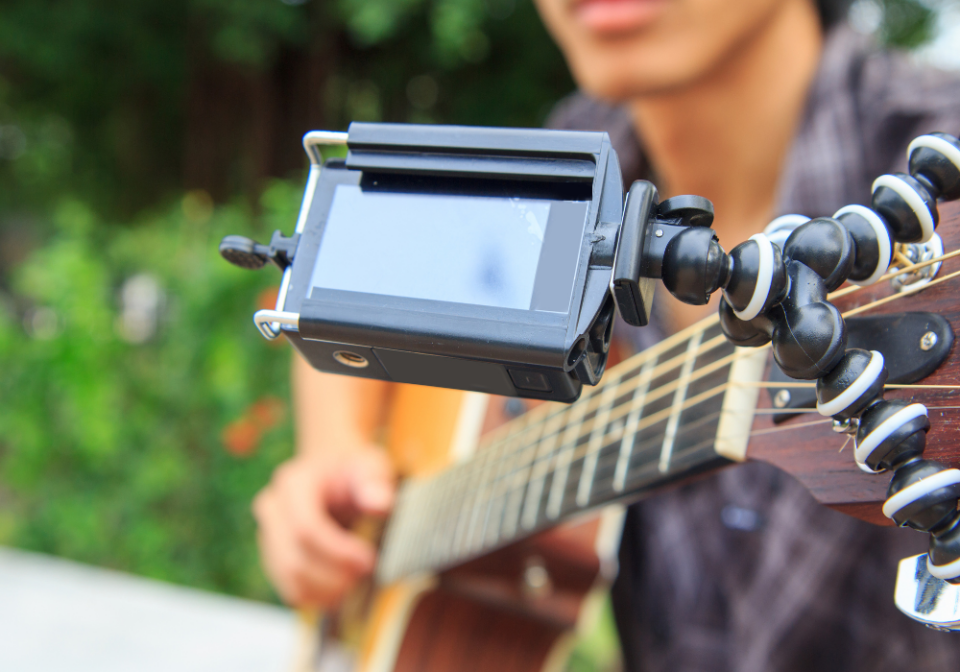
How to Choose the Best Beginner Vlogging Camera
The first step to buying a vlogging camera is understanding the essential features available, and which ones you really need.
The following are the main aspects you should consider when buying your ideal camera for vlogging.
NOTE: All the cameras that we have recommended in this guide perform well in each of these aspects.
1. Low-Light Performance
When you’re just starting out as a vlogger, you most likely don’t have enough money to spend on lighting equipment. As such, you should consider getting a camera that performs well in low light conditions. Keep in mind that “low-light” not only implies night time but also conditions where there is no enough natural lighting. That includes indoors, a cloudy or foggy scene, or in shadow areas like behind buildings or under a bridge. A camera with a poor performance in low-light will reduce its frame rate per second (fps) as it tries to let in more light when capturing the frames. The footage recorded might be blurred due to image noise.
2. Sensor Size
The bigger the sensor size, the more light the camera captures, and the better the footage quality. Sensor sizes are determined by the camera type. Camcorders and action cams have the smallest, while DSLRs and mirrorless cameras have the largest sensors. Compact cameras will fall somewhere in between, but some models feature larger 1-inch sensors. To improve their low-light performance, some compact cameras utilize a back-illuminated sensor. These sensors use a novel arrangement of the imaging elements to allow more light to be collected thus improving the camera’s low-light performance.
3. Lens Aperture
A good quality lens will have a wide aperture, which allows it to capture more light. With a wide aperture, you will also be able to achieve the blurry background effect. This gives your vlogs nice aesthetics, especially if you’re shooting lifestyle videos while sitting in front of your camera. Lens apertures are denoted by f-stops. A good f-stop range is from f/1.8 to f/22. The lower the number, the wider the aperture and, therefore, the more the light captured. Simply put, an f/1.8 aperture will let in more light and achieve a more blurred background than an f/22 aperture.
4. Optical Image Stabilization
Optical Image Stabilization (OIS) helps in stabilizing the footage by minimizing the appearance of shake when recording while moving around. Without OIS, the video will be shaky and hard to watch. When buying a vlogging camera, always look for optical or 5-axis image stabilization.
Some cameras will have Digital Image Stabilization (IS). Digital IS might do the job, but at the budget level, it isn’t as effective as OIS. Keep in mind that most budget DSLRs and Mirrorless cameras don’t come with internal image stabilization. Simply because there are a lot of affordable lenses with OIS. If you’re planning to record your videos while walking around with the camera on your hands, you will need a camera with optical image stabilization (OIS).
5. Video and Image Resolution
A good vlogging camera should record 1080p footage at 30fps. If you’re intending to capture some stills for your photography blog, then you’ll want to consider the megapixels. A 12MP camera is pretty decent for social media and blog images. Anything above this is overkill unless you’re planning to print the photos.
6. Audio Quality
Nothing turns off your audience like having good vlog content with poor audio quality. As such, always get a camera with a decent inbuilt stereo microphone. Having a microphone input for an external mic is a huge plus for a vlogging camera. We LOVE the Rode Wireless Go line!
7. Connectivity
WiFi should be a basic feature of most, if not all, vlogging cameras. With WiFi, you can easily share and transfer files to a mobile/computer device for instant uploading to YouTube and other platforms. Having NFC (Near Field Communication) and Bluetooth and output terminals like HDMI and USB is also a plus.
8. Battery Life
A camera with a good battery life will allow you to shoot massive footage and photos before you run out of charge. You can always get spare camera batteries if your favorite camera’s battery isn’t sufficient for your needs.
9. Weight and Size
A compact and lightweight camera offers portability. You can slip it in your backpack, purse or pocket. One of the best things about most budget cameras is their ultra-portable design which makes them great for on-the-go vloggers and travel bloggers.
